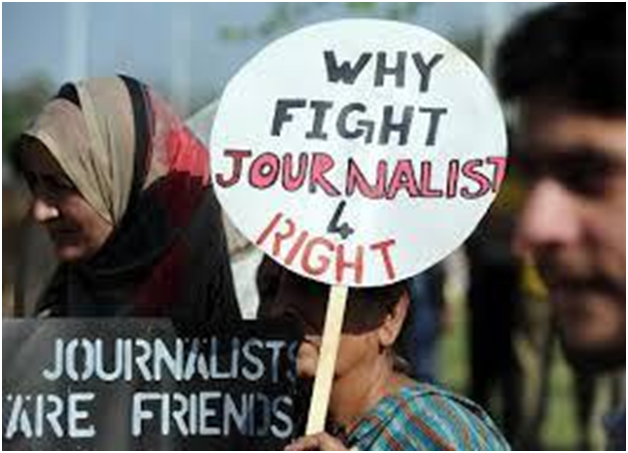Media Faces The Bullet in Pakistan, 3 Gunned Down
Pakistani Journalists Protest Against Attacks by Militants

NEW DELHI: Two journalists and one media worker from a news agency were gunned down by unknown assailants in Quetta, in Pakistan’s troubled Balochistan district. The deceased were identified as “senior journalist Irshad Mastoi, trainee reporter Abdul Rasul and an accountant Mohammed Younus.”
The attack comes as the plight of journalists in Pakistan has received widespread attention, following an attack on a prominent Pakistani television anchor, Hamid Mir, in Karachi, in April this year.
Earlier this year, a report by “Reporters Without Borders” on press freedom in the world’s countries, ranked Pakistan a low 158 of a 180 countries in terms of media freedom. The report, which measured the level of freedom of information, recorded seven journalists being murdered in connection with their work in 2013 in Pakistan. Four of them - Mohammad Iqbal of News Network International, Saifur Rehman and Imran Shaikh of Samaa News andMehmood Ahmed Afridi – were killed in Balochistan, which the report called Pakistan’s “deadliest province.”
The report further highlighted the role of the Taliban, militants and armed groups, but also the military apparatus, and agreed with international observers in calling it a “state within the state.” It also singled out intelligence agencies operating in Pakistan, especially Pakistan’s official Inter-Services Intelligence (ISI) in connection with posing a threat to journalists by “spying on media personnel, abducting them, torturing them and even murdering them.”
The reports reflects an environment of impunity, threats by intelligence agencies or attacks by non-state actors, all contributing to a security situation that compromises media freedom and targets the safety and security of media personnel.
In March this year, noted columnist and TV anchor Raza Rumi’s car was attacked, and Rumi survived the attack, his driver succumbed to injuries. Rumi’s name was on a list issued by the Tehreek-i-Taliban Pakistan (TTP) in February this year, targeting journalists who were opposed to the government’s dialogue with the banned militant outfit. The TTP also issued death threats to journalist and South Asian Free Media Association (SAFMA) Secretary General Imtiaz Alam.
Peshawar bureau chief of Express News, Jamshed Bhagwan, has been targeted twice this year, with a 2.5kg of explosives being found outside his house and grenades being thrown at his residence. Earlier this year Express News’ live van was fired at in Karachi, resulting in the death of three members of the network’s news crew.
In addition to threats by militants, journalists point to the role of Pakistan’s security agency - the ISI. “It is an open secret among journalists across the country that their phones are either tapped or can be by the intelligence, whenever they feel like it,” writes Rabia Mahmood for Al Jazeera. Mahmood refers to the intimidation tactics used by the Pakistani intelligence, giving the example of a journalist friend who was told clearly that if he would not stop reporting on the plight of Baloch people, his religious affiliation - of an Ahmadi - will be made public.
Journalist Saleem Shahzad’s death, according to many, can be linked to the ISI. In 2011, Shahzad vanished after writing about links between Al Qaeda and the Pakistan Navy. His body, which was found a few days later showed visible signs of torture. The journalist reportedly told friends and colleagues that he has been warned by intelligence agents to not report on security matters. In October 2010, Shahzad sent Dayan Hasan, a researcher at Human Rights Watch in Pakistan a note describing a meeting at the headquarters of the ISI directorate where he had been threatened, stating that the note was being sent “in case some thing happens to me or my family in the future.” In July 2011, The New York Times reported that US officials had credible information linking the ISI to Shahzad’s murder, whilst Pakistan’s official commission of inquiry concluded that the perpetrators were unknown.
In 2012, two Taliban gunmen opened fire on journalist Mukarram Khan Atif. Although the Taliban claimed responsibility for the killing on grounds that Atif had been warned not to continue his “anti-Taliban” reporting, many believe that the ISI were actually behind the murder. Atif had reportedly told friends and relatives that he had received threats from military and intelligence officials immediately after covering a November 2011 attack by US led NATO forces on Pakistani army check posts at Salala, near the Afghan border.
According to data collected by the Committee to Protect Journalists (CPJ), 54 journalists have been killed in Pakistan since 1992. This figure is probably conservative, as CPJ focuses on figures where there is a “motive confirmed,” i.e., “ a journalist was murdered in direct reprisal for his or her work; was killed in crossfire during combat situations; or was killed while carrying out a dangerous assignment such as coverage of a street protest.”
Amnesty International also issued a report that concluded that Pakistan’s authorities have almost “completely failed” to protect journalists, detailing 34 cases of journalists being killed since 2008. “Journalists in Pakistan live under the constant threat of killings, harassment and other violence from all sides, including intelligence services, political parties and armed groups like the Taliban,” the report said.



